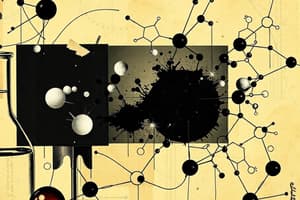Podcast
Questions and Answers
What is the best general tissue fixative?
What is the best general tissue fixative?
- Formaldehyde
- Glutaraldehyde
- Neutral Buffered Formalin (10%) (correct)
- Carnoy’s Fixative
What is the working solution concentration of Neutral Buffered Formalin?
What is the working solution concentration of Neutral Buffered Formalin?
10%
Formaldehyde is a good fixative for immunohistochemical staining.
Formaldehyde is a good fixative for immunohistochemical staining.
False (B)
What particular structures does Glutaraldehyde preserve?
What particular structures does Glutaraldehyde preserve?
Which fixative is recommended for urgent biopsy specimens?
Which fixative is recommended for urgent biopsy specimens?
Methyl Alcohol is primarily used for fixing __________ and blood smears.
Methyl Alcohol is primarily used for fixing __________ and blood smears.
Match the following fixatives with their uses:
Match the following fixatives with their uses:
Ethyl Alcohol can be mixed with chromic acid and potassium dichromate.
Ethyl Alcohol can be mixed with chromic acid and potassium dichromate.
What are Carnoy's Fixative advantages?
What are Carnoy's Fixative advantages?
Which fixative is known for preserving carbohydrates?
Which fixative is known for preserving carbohydrates?
Gendre’s solution is an improvement upon ___________ solution.
Gendre’s solution is an improvement upon ___________ solution.
Which fixative is ideal for fixing chromosomes?
Which fixative is ideal for fixing chromosomes?
What can happen if you use too high a concentration of formaldehyde?
What can happen if you use too high a concentration of formaldehyde?
Flashcards are hidden until you start studying
Study Notes
Aldehyde Fixatives
- Formaldehyde (Formalin): Pure stock at 40%, working solution generally at 10%; best for tissue preservation, prevents autolysis, and maintains morphology.
- Neutral Buffered Formalin (10%): Common choice for general tissue fixation; advantages include cost-effectiveness, tissue penetration, and compatibility with stains; disadvantages include mucosa irritation and potential staining issues.
- 10% Formal-Saline: Combination of formaldehyde and sodium chloride; ideal for CNS and general tissues; preserves microanatomical structures with minimal distortion.
- Glutaraldehyde (2%; Cold and buffered): Slower diffusion than formaldehyde; excellent for cytoplasmic/nuclear detail, stable in CNS tissues; not suitable for immunohistochemistry due to protein alteration.
- Karnovsky’s Fixative: Contains paraformaldehyde and glutaraldehyde; used for electron and light microscopy with resin embedding.
Alcoholic Fixatives
- Methyl Alcohol (100%): Fixes bone marrow and blood smears; dehydrates and fixes simultaneously.
- Isopropyl Alcohol (95%): Used for touch preparations.
- Ethyl Alcohol (70-100%): Simple fixative; used in histochemistry but can lyse RBCs at low concentrations and cause glycogen polarization.
- Carnoy’s Fixative: Rapid fixation (1-3 hours); preserves glycogen and Nissl granules; not suitable for large tissues due to excessive hardening.
- Clarke’s Solution: For frozen sections and smears; acts efficiently within 3-4 hours.
Metallic Fixatives
- Mercuric Chloride: A secondary fixative that penetrates slowly and hardens tissue, often requiring decolorization.
- Zenker’s Solution: Recommended for trichrome staining; excellent for congested tissues but not suitable for frozen sections.
- Lillie’s B-5 Fixative: Combines formaldehyde and mercuric chloride; rapid structural stabilization, used for bone marrow biopsies.
Oxidizing Agents
- Osmium Tetroxide: Used for EM; fixes fats and maintains cytoplasmic structures, but expensive and irritating.
- Flemming's Solutions: Common for nuclear structures; one variant excludes acetic acid for cytoplasmic fixation.
Chromate Fixatives
- Chromic Acid: Effective in preserving carbohydrates.
- Potassium Dichromate: Preserves mitochondria.
- Regaud’s (Muller’s) Fluid: Demonstrates various cellular structures; used for 12-48 hours.
Picric Acid Fixatives
- Bouin’s Solution: Good for embryos and pituitary biopsies; can cause RBC hemolysis but excellent for glycogen demonstration.
- Hollande’s Solution: Suitable for gastro-intestinal and endocrine tissues; has decalcifying properties.
Other Fixatives
- Glacial Acetic Acid: Preserves DNA by precipitating nuclei; important for chromosomal studies.
- Michel’s Solution: A transport medium, not a fixative; unsuitable for certain cytometry applications or immunofluorescence.
Studying That Suits You
Use AI to generate personalized quizzes and flashcards to suit your learning preferences.




